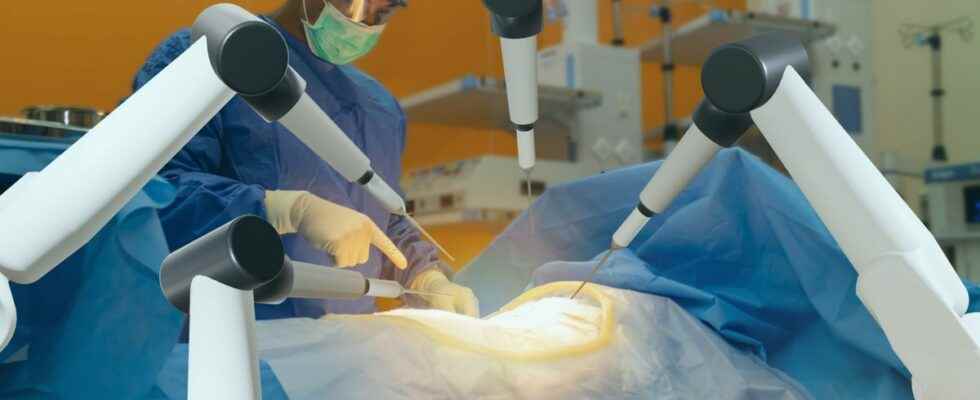Published on
Updated
Reading 3 mins.
Robots are becoming more and more essential in hospitals, where they help in particular to track down tumors and upset certain practices, even if their long-term interest has yet to be clarified.
At the Gustave Roussy hospital in the Paris region, the therapeutic imaging team is preparing the operating room for the first patient of the day. This 50-year-old suffered from breast cancer, and chemotherapy was not enough: the cancer developed two small metastases, lodged in her lungs.
The patient agreed to be treated with the help of a robot developed by a French company, Quantum Surgical. It is Professor Thierry de Baère, head of the interventional radiology department, who is in charge this early morning.
He has been using “Epione” for more than a year: a technological platform consisting of a planning and control screen, a camera that allows the robot to locate itself, and a robotic arm, which will guide the treatment needle.
The doctor is a specialist in minimally invasive operations, which consist of targeting cancerous nodules. This involves aiming for the metastasis with a fine needle, which, by emitting radiofrequency waves, will allow the nodule to be destroyed by heat.
Simplification
“We will treat the lower lesion first“, indicates the radiologist to the team of caregivers of the intervention block. “We spot our target, we look where we are going to go. Then we choose our needle“, he explains.
Once the robot has planned the route to the metastasis, and this choice has been validated by the caregiver, the information is transmitted to the robotic arm, which positions itself at the right angle: the doctor only has to push the needle in the given trajectory, into the body, until the metastasis.
It takes a few adjustments, monitored by imaging, with the patient lying directly under a scanner. In a few manipulations, the needle is in place, then connected to a generator which will destroy the cancerous lesion.
The Quantum robot has just received the prestigious Galien prize for innovative start-ups in the United States. In France, two machines equip hospitals, at Gustave Roussy and at the Lyon University Hospital. Epione has been authorized so far in abdominal cancers, a study on the lung has just started.
“The advantage of the robot is that it facilitates trajectories that are normally extremely complex“, explains the professor of Baère.
This could help democratize practices reserved for the most advanced centers, according to Bertin Nahum, president and co-founder of Quantum Surgical.
“Sticking a needle through the abdominal wall and targeting a lesion of a few millimeters is a difficult act, often reserved for a few radiologists. Robotics makes it possible to generalize an act with very high added value“, he says.
High cost
Robots in radiology are relatively new, while in surgery they have been around for almost twenty years. There are thus thousands of copies throughout the world of the very first, “Da Vinci”, from the American group Intuitive Surgical, leader in the sector.
The global market for surgical robots – $5 billion in 2021 – is expected to reach $21 billion by 2030, according to Strategic Market Research. But this equipment has a significant cost – around 1 million euros for Epione – which raises the question of its superiority. A few years ago, the American health authorities had also indicated that there was no proof of the improvement of procedures by robot, at least in certain cancers.
“Survival benefits compared to conventional surgery are unclear“, they had judged.
The interest of these robots must therefore be better assessed, as Professor Morgan Roupret, surgeon in charge of the robots program at the AP-HP, believes.
“This is why at the AP-HP, we are in the process of creating a database of patients operated on by robot, so as to demonstrate in real life that they are operated on in better conditions than those operated on traditional method“, he underlines. The surgeon cites in particular fewer complications, or even smaller scars for patients.
